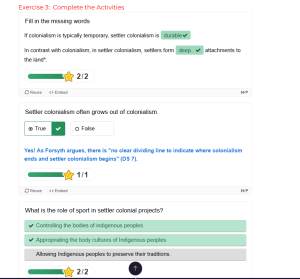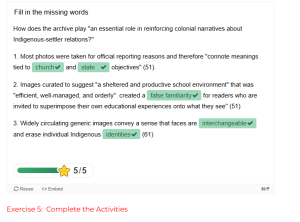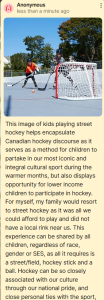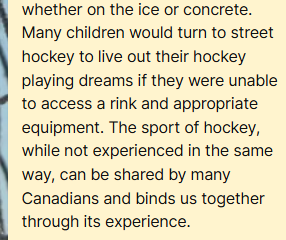4
These are difficult stories. We bear witness in this chapter to the role of sport in furthering the settler colonial projects throughout Turtle Island. Here are some supports to access in the community and from a distance:
First Peoples House of Learning Cultural Support & Counselling
Niijkiwendidaa Anishnaabekwag Services Circle (Counselling & Healing Services for Indigenous Women & their Families) – 1-800-663-2696
Nogojiwanong Friendship Centre (705) 775-0387
Peterborough Community Counselling Resource Centre: (705) 742-4258
Hope for Wellness – Indigenous help line (online chat also available) – 1-855-242-3310
LGBT Youthline: askus@youthline.ca or text (647)694-4275
National Indian Residential School Crisis Line – 1-866-925-4419
Talk4Healing (a culturally-grounded helpline for Indigenous women):1-855-5544-HEAL
Section One: History
A) The Residential School System
Exercise 1: Notebook Prompt
We are asked to honour these stories with open hearts and open minds.
Which part of the chapter stood out to you? What were your feelings as you read it? (50 words)
| A part of the chapter that stood out to me was the Sports: “Truly Anglo-Saxon vigor”. It explained how the rules of common games such as football, baseball, and hockey were established at the same time as residential schools. It was eye-opening to understand how sport was used as a method of “civilizing” Indigenous children. It was upsetting to learn that sports have been used as a method of forced assimilation and that the concept of “manliness” has been weaponized for decades.
|
B) Keywords
Exercise 2: Notebook Prompt
Briefly define (point form is fine) one of the keywords in the padlet (may be one that you added yourself).

|
C) Settler Colonialism
Exercise 3: Complete the Activities

Exercise 4: Notebook Prompt
Although we have discussed in this module how the colonial project sought to suppress Indigenous cultures, it is important to note that it also appropriates and adapts Indigenous cultures and “body movement practices” (75) as part of a larger endeavour to “make settlers Indigenous” (75).
What does this look like? (write 2 or 3 sentences)
| The colonization of typical Indigenous activities and sport into settler practices and participation. For instance, the practice of transforming canoeing into a white sporting event but excludes indigenous participation and does not recognize its cultural and historical roots. It is the exclusion of Indigenous people within their own sports and activities, where “making settlers Indigenous” refers to the forceful adaptations of Indigenous culture, practices and activities into settler sport. This appropriation rebrands Indigenous histories and cultures as settler sport and extracts the cultural importance of these activities.
|
D) The Colonial Archive

Exercise 5: Complete the Activities
Section Two: Reconciliation
A) Reconciliation?
Exercise 6: Activity and Notebook Prompt
Visit the story called “The Skate” for an in-depth exploration of sport in the residential school system. At the bottom of the page you will see four questions to which you may respond by tweet, facebook message, or email:
How much freedom did you have to play as a child?
What values do we learn from different sports and games?
When residential staff took photos, what impression did they try to create?
Answer one of these questions (drawing on what you have learned in section one of this module or prior reading) and record it in your Notebook.
| How much freedom did you have to play as a child?
I had a fair amount of freedom to play as a child, where personal play or chances to partake in sport were reasonable within the context of where I lived and how my parents interacted with me when I was a child. However, I still had very little interest partaking in the sports side of play and recreation and it never interested me as much as individual play with toys did. I remember if I was presented an opportunity to play a sport outside with my family, I would either refuse or begrudgingly participate because I would be forced to. Looking at the experiences of Indigenous children in residential schools, some of their only chances to partake in play was through sport, and many children cherished their opportunities to partake in any sporting activity. Sports for me was an interruption in my daily life, however for thee children, they were a survival strategy. Looking at the stark contrast between my childhood and perception of sports and the experiences indigenous children faced in restrictive residential school environments, I did not realize how much play is a privilege. I often would prefer to be by myself when I played or when I was presented the opportunity to play, but for Indigenous children, it was one of the few times to develop solidarity and relationships with their peers. Taking my personal experience with something taken for granted, such as play, outside of my own personal context and applying it to the experiences of children in residential schooling has made me realize the importance of sport as a method of play. Seeing the experience of sport through the eyes of someone restricted in their opportunities to play was amazing to witness the development of relationships, support and solidarity, even if it was being used as a tool for assimilation and colonization. Overall, sports as a method of support in times of restriction was key for these Indigenous children in residential schools, and was eye opening to understand stemming from my personal experiences of unrestricted play and sport access.
|
B) Redefining Sport
B) Sport as Medicine
Exercise 7: Notebook Prompt
Make note of the many ways sport is considered medicine by the people interviewed in this video.
|
C) Sport For development
Exercise 7: Notebook Prompt
What does Waneek Horn-Miller mean when she says that the government is “trying but still approaching Indigenous sport development in a very colonial way”?
| The attempts towards Indigenous sport development are approached in a colonial way as the government is approaching the issue with out the consultation or inclusion of Indigenous knowledge or input. By approaching Indigenous sport without the inclusion of Indigenous people themselves, the government still continues to perpetuate the systemic colonial practices imbedded in their systems and structure. The attempts by the government include providing funding and money towards indigenous athletes, however, these are band aid solutions that do not address the systemic issues associated with indigenous participation. The lack of infrastructure and access are key components of the barriers that restrict the development of Indigenous athletes. The government is only addressing the surface level issues of inadequate funding, and ignores the underlying factors such as racism, discrimination, access and representation. The government ignores these underlying issues and continues to perpetuate a colonial system. Historically, sports were used as an assimilation tactic for Indigenous youth, and to this day, there has been no established concrete indigenous methods of reconciliation for this issue and continues to operate on this system built from oppression. The government ignores the importance of Indigenous lead recreation centers and opportunities for engagement and instead focuses on providing funding for pre established opportunities that are inaccessible to a large portion of the Indigenous population. In order to move away from these colonial methods, systemic addressing of barriers to Indigenous access and inclusion of Indigenous knowledge and culture would allow for a more holistic approach to indigenous sport development. |
Exercise 8: Padlet Prompt
Add an image or brief comment reflecting some of “binding cultural symbols that constitute Canadian hockey discourse in Canada.” Record your responses in your Notebook as well.
 
|
Section Three: Decolonization
Please see the major assignment for this half of the term in the final section of this chapter.

